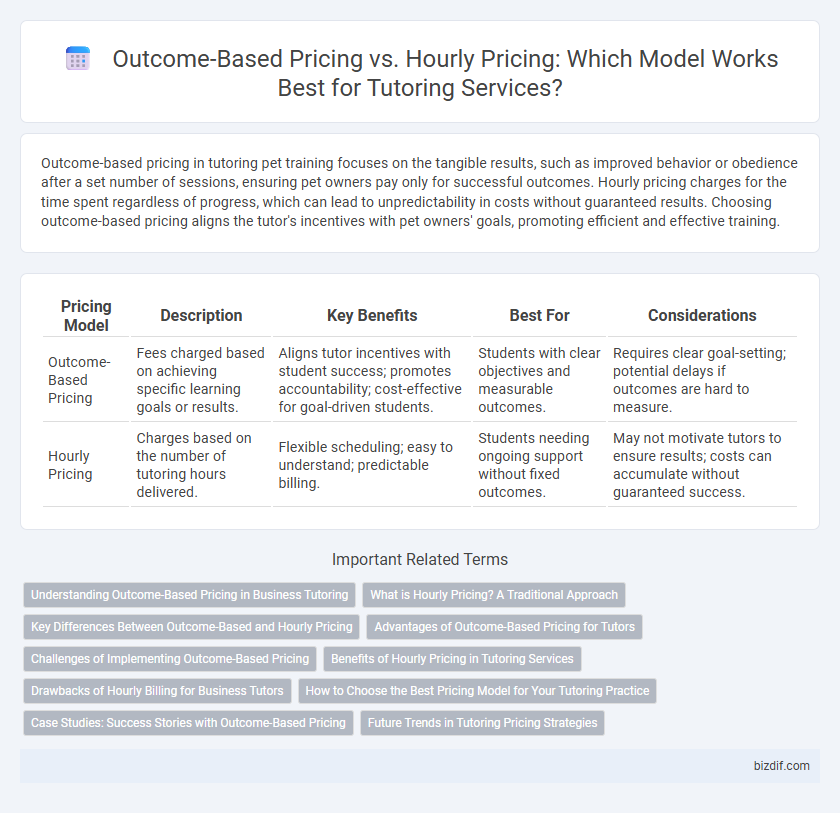Outcome-based pricing in tutoring pet training focuses on the tangible results, such as improved behavior or obedience after a set number of sessions, ensuring pet owners pay only for successful outcomes. Hourly pricing charges for the time spent regardless of progress, which can lead to unpredictability in costs without guaranteed results. Choosing outcome-based pricing aligns the tutor's incentives with pet owners' goals, promoting efficient and effective training.
Table of Comparison
| Pricing Model | Description | Key Benefits | Best For | Considerations |
|---|---|---|---|---|
| Outcome-Based Pricing | Fees charged based on achieving specific learning goals or results. | Aligns tutor incentives with student success; promotes accountability; cost-effective for goal-driven students. | Students with clear objectives and measurable outcomes. | Requires clear goal-setting; potential delays if outcomes are hard to measure. |
| Hourly Pricing | Charges based on the number of tutoring hours delivered. | Flexible scheduling; easy to understand; predictable billing. | Students needing ongoing support without fixed outcomes. | May not motivate tutors to ensure results; costs can accumulate without guaranteed success. |
Understanding Outcome-Based Pricing in Business Tutoring
Outcome-based pricing in business tutoring aligns fees with tangible results such as improved grades, skill mastery, or specific business project completions, enhancing accountability and motivation. This model shifts focus from time spent to the value delivered, ensuring that tutor compensation reflects student success and measurable progress. Tutors and clients benefit from clear performance indicators that drive targeted learning outcomes and optimize resource allocation.
What is Hourly Pricing? A Traditional Approach
Hourly pricing in tutoring refers to charging students a fixed rate for each hour of instruction, a traditional approach that offers straightforward cost estimation. This model allows flexibility in scheduling and accommodates fluctuating learning durations, making it popular among tutors and learners. Despite its simplicity, hourly pricing may not always align with the quality of outcomes or student progress, which has led to the consideration of alternative models like outcome-based pricing.
Key Differences Between Outcome-Based and Hourly Pricing
Outcome-based pricing focuses on measurable student achievements, such as test score improvements or skill mastery, aligning tutor compensation with specific educational results. Hourly pricing charges based on the time spent tutoring, regardless of progress or outcomes, providing straightforward billing but less emphasis on the effectiveness of sessions. Key differences include the risk distribution, with outcome-based pricing incentivizing tutors to deliver results, while hourly pricing offers predictable costs for families but less motivation for rapid progress.
Advantages of Outcome-Based Pricing for Tutors
Outcome-Based Pricing empowers tutors to align their fees with student success, fostering a results-driven approach that enhances motivation and accountability. This pricing model can increase client satisfaction by directly linking payment to measurable academic improvements, such as test scores or skill mastery. Tutors benefit from predictable income tied to performance, encouraging personalized and effective teaching strategies that drive student achievement.
Challenges of Implementing Outcome-Based Pricing
Implementing outcome-based pricing in tutoring faces challenges such as accurately measuring student progress and attributing improvements solely to tutoring sessions, which can be influenced by external factors like self-study or classroom instruction. Determining fair and consistent outcome metrics requires reliable assessment tools and ongoing data collection, increasing administrative complexity. Furthermore, tutors may be hesitant to adopt this model due to income uncertainty compared to the predictability of hourly pricing.
Benefits of Hourly Pricing in Tutoring Services
Hourly pricing in tutoring services offers transparent cost management, allowing students and parents to pay strictly for the time spent on personalized instruction. This pricing model provides flexibility, enabling adjustments in session length and frequency according to the student's evolving academic needs. Hourly rates also encourage tutors to focus on delivering quality in each session, fostering measurable improvements in student performance.
Drawbacks of Hourly Billing for Business Tutors
Hourly pricing for business tutors often limits earnings potential by capping revenue to time spent, disregarding the value delivered or learning outcomes achieved. This model may discourage efficient teaching methods and prioritizes quantity over quality, reducing overall client satisfaction. It also complicates forecasting and budgeting for both tutors and clients, as costs fluctuate with session length rather than fixed deliverables.
How to Choose the Best Pricing Model for Your Tutoring Practice
Selecting the optimal pricing model for your tutoring practice depends on factors such as student goals, subject complexity, and session frequency. Outcome-based pricing aligns well with measurable improvements and goal-oriented learners, providing value-driven incentives for both tutor and student. Hourly pricing suits flexible, ongoing support scenarios where progress is less quantifiable, offering straightforward cost expectations without performance conditions.
Case Studies: Success Stories with Outcome-Based Pricing
Case studies in tutoring demonstrate that outcome-based pricing enhances student motivation and accountability by aligning costs with measurable academic improvements. For example, a math tutoring program reported a 30% increase in student test scores after implementing outcome-based fees, leading to higher customer satisfaction and retention rates. These success stories highlight how outcome-based pricing drives better educational results compared to traditional hourly pricing models.
Future Trends in Tutoring Pricing Strategies
Outcome-based pricing in tutoring aligns fees with student performance improvements, promoting accountability and measurable results. Hourly pricing remains prevalent but faces increasing scrutiny as personalized learning demands more flexible, outcome-focused models. Emerging trends suggest a shift towards hybrid pricing strategies that combine fixed hourly rates with success-based incentives to better meet evolving educational goals.
Outcome-Based Pricing vs Hourly Pricing Infographic

 bizdif.com
bizdif.com